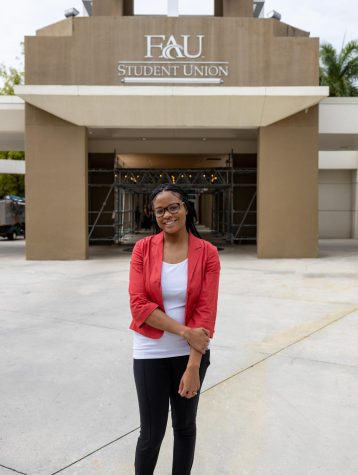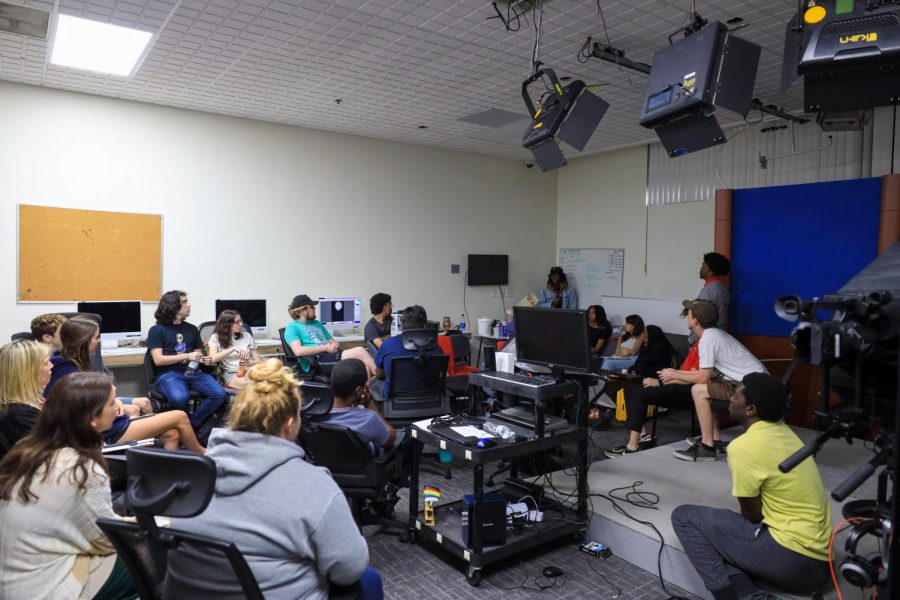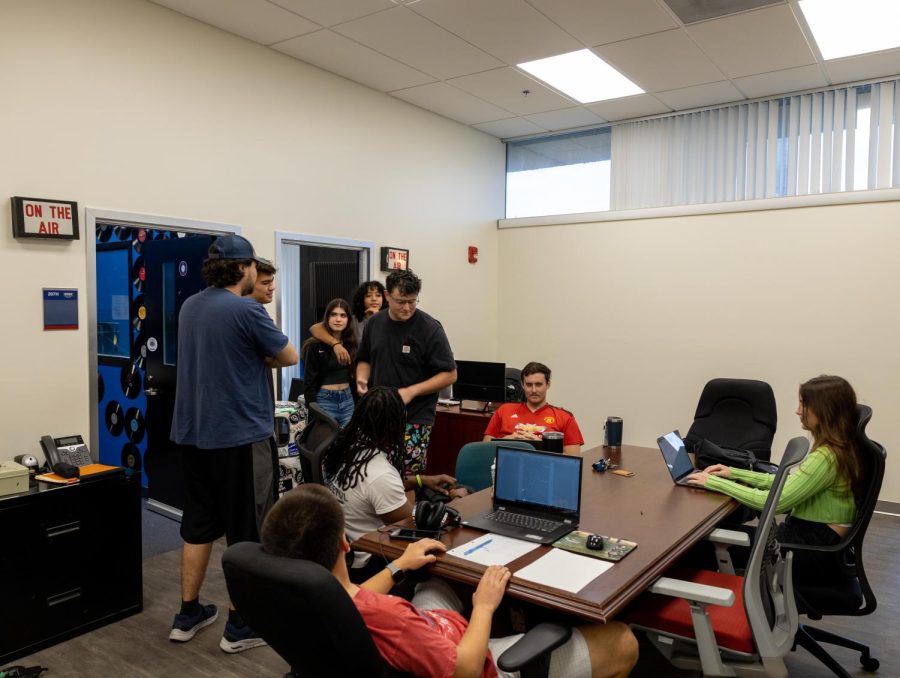‘White leaders in the newsroom’: How white media leaders affect Black students
Students are less likely to join student media for various reasons, including mistrust.
Owl TV holds their first general meeting of the Spring 2023 semester after the Student Media Open House.
February 17, 2023
Minorities have been underrepresented in the media. The cause of this can be attributed to different reasons: education, lack of opportunity, and even racism.
The University Press decided to look into disparities of diversity in newsrooms and student media at FAU.
National Data in Media
The Associated Press, a major news organization, reported that 76% of its full-time news employees in the U.S. are white, 8% are Latino, 7% are Black, and 6% are Asian; news management staff is 81% white.
An article by Pew Research shows that American adults — Black, Hispanic, and white — feel that the media does not understand them, but for very different reasons.
Pew reports that Black Americans are more likely than Hispanic and white Americans to feel that the media does not understand them due to their race or another demographic trait.
“Among Black adults who think the news media do not understand people like them, about a third (34%) say the main way they are misunderstood is their personal characteristics. This is far higher than the 10% of white adults and 17% of Hispanic adults who say the same,” the article states.
FAU’s Diversity Data Report for 2019-2021 shows that 19.8% of the student population is Black.
Tamia Fowlkes, a National Association of Black Journalists (NABJ) student representative, Columbia Journalism School graduate student, and USA Today digital producer, believes that “journalism is all about finding and telling people’s stories and in providing space to offer insight into issues that haven’t been explored before.”
NABJ is an organization that assists Black journalists with their education, internships, and job opportunities.
“We have a student membership program,” Fowlkes said. “I think it’s about $40 to join and that offers students opportunities to apply for scholarships, oftentimes up to like $10,000 to support their academic studies, or other internship opportunities and things like that, but specifically function to serve NABJ students.”
FAU Student Media
The station managers of Owl TV and Owl Radio believe their staffs are more diverse, as the UP currently has two Black editors out of eight.
Pete Gordon, a Black student and Owl TV’s station manager, said the organization has been predominantly Black and Latino since he joined in 2019.
“As FAU is known for its diversity, I don’t think I would get that sense if it wasn’t for Owl TV. The past five station managers, including myself, have been people of color,” Gordon wrote in a statement.
Luke Campese, station manager of Owl Radio, shares that the staff at the station includes an array of different people.
“The staff at Owl Radio is very diverse. Addiel, the director is Latino, the business manager is an international student from Brazil, and our promotions director is Black, as well as our head deejay,” wrote Campese in a statement.
Current UP adviser Wesley Wright is the only Black UP editor-in-chief in the last 25 years. He believes that some students might be skeptical of the media and others don’t feel understood by reporters.
“There’s this distrust between media institutions, and Black Americans more broadly, just because of shoddy journalism over the years and even though that’s not the UP’s fault, that bleeds to some extent, into how Black students deal with UP,” Wright explained.
Tamara Buck, professor and chair of the Department of Mass Media at Southeast Missouri State University, and former student media adviser, agreed with Wright.
“There are very few students and it’s typically a lack of opportunity that comes around, we persons of color experience when we enter mostly white newsrooms,” Buck said. “But when you enter mostly white newsrooms, you find yourself challenged, in many ways, because your perspective is different as to what is news and your perspective is not always welcomed and understood.”
Buck said when editors do not understand someone’s perspective and opinions, they are forced to constantly explain themselves and why their idea is newsworthy.
“All of those explanations over time can develop frustrations,” Buck stated. “Which will take talent away from your newsroom. It’s something honestly, a lot of white leaders in the newsroom don’t have to experience and so they don’t recognize it. It’s a problem.”
Emily Bloch was Wright’s managing editor and attended FAU from 2012-2016. She currently works at The Philidelphia Inquirer.
Bloch said Wright was well respected by the staff. She said that Wright made her job easy because staff relations were “calm and amicable” while he was editor-in-chief.
“I don’t think we did a perfect job [reporting on diverse issues], but it’s something that we had discussions about, but it was very apparent that over the years, student media’s relationship with underrepresented communities, including the Black student community, was fractured or strained,” Bloch said. “And I think you can see that in some of our coverage. We were working to gain that trust from Black student representation.”
Kennedy McKinney, who graduated in Fall 2022, founded The Paradigm Press in 2020 under the impression that the UP did not adequately represent the Black community.
“I started the Paradigm Press to give a voice to the minority community at FAU,” McKinney wrote. “The paper serves as a place for us to express our concerns and celebrate our accomplishments.”

Hannah Burrell is a Black multimedia journalism major and current editor-in-chief of the Paradigm Press. She said she joined the organization because of her journalism background and being a part of her high school newspaper.
Burrell says that anyone in the FAU community can write stories for the UP or The Paradigm Press, as it is a journalist’s job. However, she says there are differences between the UP and the Paradigm Press.
“The difference is that Paradigm Press and UP have cultural differences in terms of what they want to publish in the press. UP covers general topics at FAU whereas Paradigm Press writes stories that pertain specifically to our culture,” Burrell wrote in a statement. “It is a safe space for minorities — in terms of writing about social and cultural issues within the Black community as well as celebrating our accomplishments in the community and at our school.”
Gordon believes that Black students should join student media organizations because it allows them to make more friends, and for some, it provides a sense of belonging.
Gordon figured he would struggle to make friends in college because he isn’t a “super film nerd,” in comparison to other film majors. He credits Owl TV for allowing him to easily make friends with common interests. He doesn’t think he would still be attending FAU without student media.
“Another reason is that it gives us the chance to tell our stories that other people won’t tell, and it allows us to tell those stories right,” Gordon wrote. “Whether it be highlighting Black student organizations and events, or giving light to issues or stories that should be talked about more, joining student media gives us the power to speak on subjects that are often left unspoken on.”
Ways to diversify student media
Buck urges student media leaders to recruit students by going into classrooms, talking to students around campus, critiquing publications, and conducting culturally inclusive discussions and training amongst the staff.
Ryan Lynch is a current reporter at the Orlando Business Journal, and he was a staff writer during Wright’s time in the university. Lynch believes recruiting in classes is very important for student media because it will get more people involved and provide more opinions and ideas in the newsroom.
“You can always do better on the recruiting side, and that’s saying just in a general sense, like, [student media leaders] will say ‘Oh, I’ll do a better job recruiting’ but you know, it’s about going into classes and clubs but it can also be a perception,” Lynch said.
Fowlkes agreed, claiming student news organizations many times may not be immediately aware of where they can better their efforts.
“Sometimes our biggest blind spots come from being within the same group of people and not always seeing where we’re missing an opportunity to connect with new people, or new groups, or people who might be intimidated by the prospect of joining an organization,” Fowlkes said.
Jessica Abramsky is the News Editor for the University Press. For more information on this article or others, you can reach Jessica at [email protected] or DM her on Instagram @jessabramsky.







